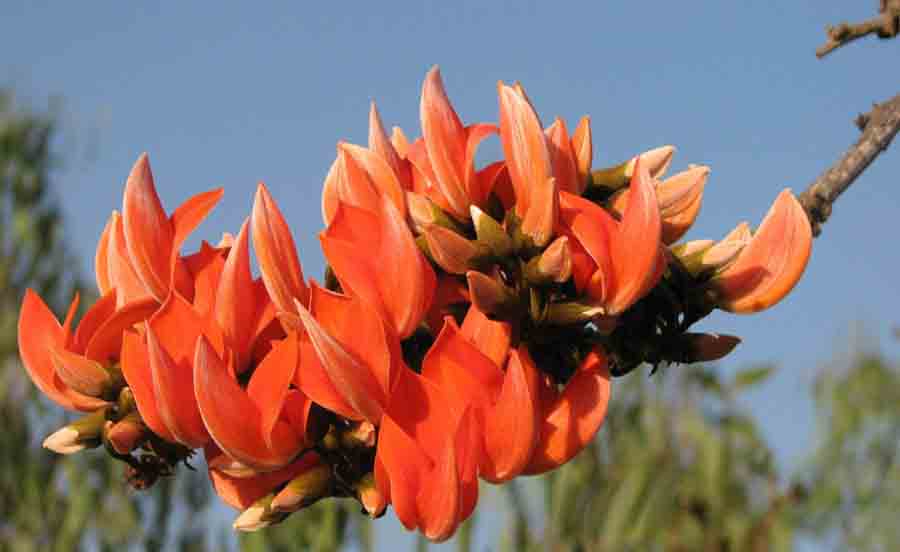Kimshuka tree
Kimshuka or Butea monosperma is a species of Butea native to tropical and sub-tropical parts of the Indian Subcontinent and Southeast Asia, ranging across India, Bangladesh, Nepal, Sri Lanka, Myanmar, Thailand, Laos, Cambodia, Vietnam, Malaysia, and western Indonesia. Common names include flame-of-the-forest and bastard teak.
It is a medium-sized dry season-deciduous tree, growing to 15 m (49 ft) tall. It is a slow growing tree, young trees have a growth rate of a few feet per year. The leaves are pinnate, with an 8–16 cm (3.1–6.3 in) petiole and three leaflets, each leaflet 10–20 cm (3.9–7.9 in) long. The flowers are 2.5 cm (0.98 in) long, bright orange-red, and produced in racemes up to 15 cm (5.9 in) long. The fruit is a pod 15–20 cm (5.9–7.9 in) long and 4–5 cm (1.6–2.0 in) broad.
In West Bengal, it is associated with spring, especially through the poems and songs of Nobel Laureate Rabindranath Tagore, who likened its bright orange flame-like flower to fire. In Santiniketan, where Tagore lived, this flower has become an indispensable part of the celebration of spring. The plant has lent its name to the town of Palashi, famous for the historic Battle of Plassey fought there.
In the state of Jharkhand Palash is associated with the folk tradition. Many folk literary expressions describe palash as the forest fire. The beauty of dry deciduous forests of Jharkhand reach their height when most trees have fallen their leaves and Palash is in its full bloom. Palash is also the State Flower of Jharkhand.
It is said that the tree is a form of Agni, God of Fire. In Telangana, these flowers are specially used in the worship of Lord Shiva on occasion of Shivratri. In Telugu, this tree is called Modugu chettu.
In Kerala, this is called 'plasu' and 'chamata'. Chamata is the vernacular version of Sanskrit word 'Samidha', small piece of wood that is used for 'agnihotra' or fire ritual. In most of the old Namboodiri (Kerala Brahmin) houses, one can find this tree because this is widely used for their fire ritual. Tamil Brahmins have a daily Agnihotra ritual called "Samidha Dhanan", where barks of this tree is a main component for agnihotra, and this ritualis very essential for Brahmacharis during the first year of Brahmacharya.
Flame of the Forest is otherwise known as Bastard Teak, Parrot Tree (Eng.), Chichra tesu, desuka jhad, dhaak, palaash, chalcha, kankrei (Hindi), PaLash (पळस) (Marathi), Palashpapra (Urdu), Muthuga (ಮುತ್ತುಗ)(Kannada.), Kinshuk, Polash (পলাশ) Bengali, Pauk (Burmese), Polash (Polax) in Assamese, Porasum, Parasu (Tam.), Muriku, Shamata (Mal.), Modugu(మోదుగ) (Telugu), Khakda (Guj.).
In Sanskrit, the flower is extensively used as a symbol of the arrival of spring and the colour of love. Jayadeva in the Gita Govindam compares these blossoms to the red nails of Kamadeva or Cupid, with which he wounds the hearts of lovers. The imagery is all the more appropriate as the blossoms are compared to a net of kimsuka flowers(किंशुकजाले). In a completely leafless tree, the blossoms look like a net.
The following stanza is translated here by Barbara Stoller Miller, for Kimsuka blossoms, she uses the common name "flame tree petals":
- मृगमदसौरभरभसवशंवदनवदलमालतमाले।
- युवजनहृदयविदारणमनसिजनखरुचिकिंशुकजाले॥
- Tamala tree's fresh leaves absorb strong scent of deer musk.
- Flame tree petals, shining nails of love, tear at young hearts.
-
- Gita Govinda of Jayadeva, Love Song of the Dark Lord, Motilal Banarsidass
